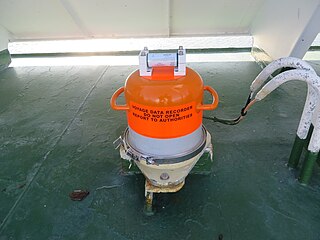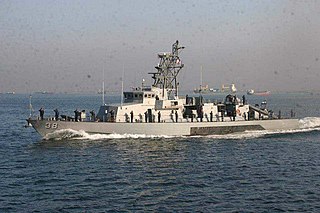
LÉ Niamh (P52) is a Róisín-class offshore patrol vessel in the Irish Naval Service. The ship is named after Niamh, queen of Tír na nÓg, from Irish mythology. Commissioned in 2001, as of 2020 the ship was in active service.

LÉ Róisín (P51) is the lead ship of her class of offshore patrol vessel in the Irish Naval Service. Commissioned in 1999, the ship's primary mission is fisheries protection, search and rescue, and maritime protection operations, including vessel boardings. Róisín or Róisín Dubh, is often used as an allegory for Ireland. However, the original Róisín Dubh was a daughter of Red Hugh O’Neill, Earl of Tyrone in the late 16th century.

The Philippine Coast Guard (PCG) is the third armed uniformed service of the country attached to the Philippines' Department of Transportation, tasked primarily with enforcing laws within Philippine waters, conducting maritime security operations, safeguarding life and property at sea, and protecting marine environment and resources; similar to coast guard units around the world. In case of a declaration of war, the Coast Guard shall also serve as an attached service of the Department of National Defense.

Voyage data recorder, or VDR, is a data recording system designed for all vessels required to comply with the IMO's International Convention SOLAS Requirements in order to collect data from various sensors on board the vessel. It then digitizes, compresses and stores this information in an externally mounted protective storage unit. The protective storage unit is a tamper-proof unit designed to withstand the extreme shock, impact, pressure and heat, which could be associated with a marine incident.

RV Western Flyer is a twin hulled SWATH research vessel operated by the Florida Institute of Oceanography (FIO). In November 2022, the R/V Western Flyer was acquired by the Florida Institute of Oceanography and its Host Institution, the University of South Florida. The custom-designed ship was granted to FIO by the Monterrey Bay Aquarium Research Institute (MBARI) for use as a sailing classroom and platform for FIO’s new ROV and peer mentoring program, providing new opportunities for students who dream of a career in Ocean STEAM.

The Pacific class is a class of 22 patrol boats built by Australia and donated to twelve South Pacific countries. They were constructed between 1985 and 1997 and are operated by militaries, coast guards or police forces of twelve island nations. These boats are supported by the Pacific Patrol Boat Program and used primarily for maritime surveillance and fisheries protection.

ARM Sonora (PO-152) is a Durango-class patrol vessel in service with the Mexican Navy with a 57 mm (2.2 in) main gun turret and a helicopter landing pad, primarily used for illicit drug interdiction. Like other ships of this class, it was designed and built in Mexican dockyards. The vessel was launched and commissioned on 4 September 2000 and is in active service.
SCF Sakhalin is a Russian icebreaking platform supply and standby vessel owned by SCF Sakhalin Vessels Limited, a subsidiary of Sovcomflot. The ship was built by Aker Finnyards Helsinki shipyard in Finland in 2005 as FESCO Sakhalin for Far East Shipping Company (FESCO), but was purchased by Sovcomflot and renamed in 2010. Since the beginning it has been in long-term charter for Exxon Neftegas Ltd. and used to supply oil platforms in the Sakhalin-I project.

BRP General Mariano Alvarez (PS-38) is the lead ship of its class of three coastal patrol ships currently in service with the Philippine Navy. She was the lead ship of the US Navy's Cyclone-class patrol ship prior to being transferred to the Philippine Navy.

Seahorse Mercator is a navigational training vessel operated by Defence Maritime Services under contract to the Royal Australian Navy (RAN). She is a modified version of the Pacific-class patrol boat design and is based at HMAS Waterhen in Sydney.
The BRP Simeon Castro (PC-374) is the fourth ship of the Jose Andrada class coastal patrol boats of the Philippine Navy. It is part of the first batch of its class ordered through US Foreign Military Sales (FMS) in 1989, and was commissioned with the Philippine Navy on 24 June 1991. It was initially designated as Fast Patrol Craft, and was numbered "DF-374", but later on was re-designated as a Patrol Gunboat, and was re-numbered as "PG-374", until another round of reclassification changed its designation as a Patrol Craft with hull number "PC-374" from April 2016.

The Parola-class patrol vessel consists of ten vessels currently in service with the Philippine Coast Guard. Their hull number prefix "MRRV" means they are officially classified as "multi-role response vessels". They will be named after primary lighthouses in the Philippines, with the Filipino word "Parola" meaning "lighthouse" in English. The lead ship, BRP Tubbataha, is named after a major lighthouse situated in the Tubbataha Marine National Park in Palawan.

BRP Malabrigo (MRRV-4402) is the second ship of the Parola-class patrol vessels of the Philippine Coast Guard.
BRP Cape San Agustin (MRRV-4408) is the seventh ship of the Parola-class patrol vessels of the Philippine Coast Guard.

BRP Gabriela Silang (OPV-8301) is an offshore patrol vessel of the Philippine Coast Guard. She is the first offshore patrol vessel and currently, the second largest and most modern vessel of the Philippine Coast Guard. Named after Gabriela Silang, a revolutionary leader during the Philippine struggle for independence from Spain. She was constructed by French shipbuilder OCEA S.A. based on the OPV-270 Mk II design, in Les Sables-d'Olonne, France.

As a major port, there is a long history of fireboats in Singapore.

JS Nichinan (AGS-5105) is the only ship of her type of oceanographic research ship for the Japan Maritime Self-Defense Force.

The BRP Teresa Magbanua (MRRV-9701) is the lead ship of her class of patrol vessels operated by the Philippine Coast Guard (PCG). The service officially classifies her as a multi-role response vessel (MRRV). She is one of the largest, and most modern vessels of the PCG.

The Teresa Magbanua-class patrol vessels is class of patrol vessel built for the Philippine Coast Guard (PCG). The class is based on the Japan Coast Guard's Kunigami-class design.

Vsevolod Bobrov is an Elbrus-class logistics support vessel in the Russian Navy. Built by the Severnaya Verf Shipyard from 2013 to 2021, the ship is used for transporting dry cargo, water, and ammunition, as well as providing search-and-rescue, medical support, and towing capabilities. The ship was named after the Soviet football and ice hockey player Vsevolod Bobrov.

















